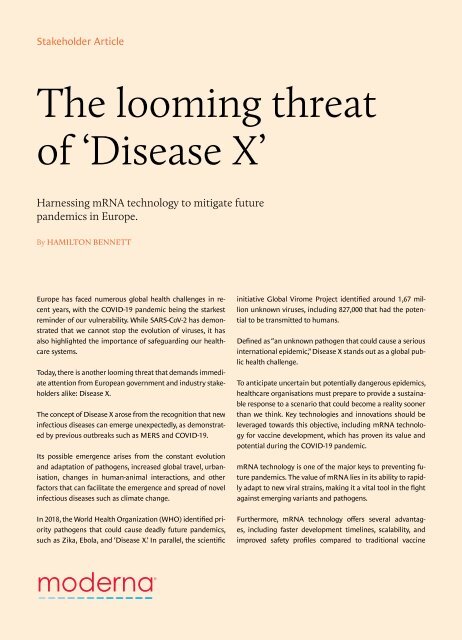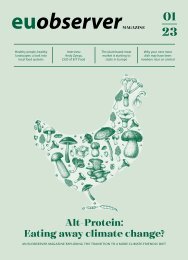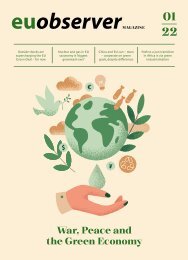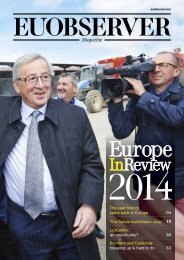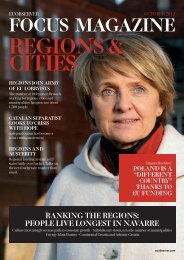Health in a post-pandemic EU
As this magazine goes to press, the World Health Organisation has registered just shy of seven million global deaths due to COVID-19. It also has registered over 13.5 billion doses of vaccines administered. When it comes to health, it’s truly an extraordinary period to be alive. And to stay alive, if all works out as it seems to be doing.
As this magazine goes to press, the World Health Organisation has registered just shy of seven million global deaths due to COVID-19. It also has registered over 13.5 billion doses of vaccines administered. When it comes to health, it’s truly an extraordinary period to be alive. And to stay alive, if all works out as it seems to be doing.
You also want an ePaper? Increase the reach of your titles
YUMPU automatically turns print PDFs into web optimized ePapers that Google loves.
Stakeholder Article<br />
The loom<strong>in</strong>g threat<br />
of ‘Disease X’<br />
Harness<strong>in</strong>g mRNA technology to mitigate future<br />
<strong>pandemic</strong>s <strong>in</strong> Europe.<br />
By HAMILTON BENNETT<br />
Hamilton Bennett is the Senior<br />
Director of Vacc<strong>in</strong>e Access and<br />
Partnerships at Moderna.<br />
Europe has faced numerous global health challenges <strong>in</strong> recent<br />
years, with the COVID-19 <strong>pandemic</strong> be<strong>in</strong>g the starkest<br />
rem<strong>in</strong>der of our vulnerability. While SARS‐CoV‐2 has demonstrated<br />
that we cannot stop the evolution of viruses, it has<br />
also highlighted the importance of safeguard<strong>in</strong>g our healthcare<br />
systems.<br />
Today, there is another loom<strong>in</strong>g threat that demands immediate<br />
attention from European government and <strong>in</strong>dustry stakeholders<br />
alike: Disease X.<br />
The concept of Disease X arose from the recognition that new<br />
<strong>in</strong>fectious diseases can emerge unexpectedly, as demonstrated<br />
by previous outbreaks such as MERS and COVID-19.<br />
Its possible emergence arises from the constant evolution<br />
and adaptation of pathogens, <strong>in</strong>creased global travel, urbanisation,<br />
changes <strong>in</strong> human-animal <strong>in</strong>teractions, and other<br />
factors that can facilitate the emergence and spread of novel<br />
<strong>in</strong>fectious diseases such as climate change.<br />
In 2018, the World <strong>Health</strong> Organization (WHO) identified priority<br />
pathogens that could cause deadly future <strong>pandemic</strong>s,<br />
such as Zika, Ebola, and ‘Disease X.’ In parallel, the scientific<br />
<strong>in</strong>itiative Global Virome Project identified around 1,67 million<br />
unknown viruses, <strong>in</strong>clud<strong>in</strong>g 827,000 that had the potential<br />
to be transmitted to humans.<br />
Def<strong>in</strong>ed as “an unknown pathogen that could cause a serious<br />
<strong>in</strong>ternational epidemic,” Disease X stands out as a global public<br />
health challenge.<br />
To anticipate uncerta<strong>in</strong> but potentially dangerous epidemics,<br />
healthcare organisations must prepare to provide a susta<strong>in</strong>able<br />
response to a scenario that could become a reality sooner<br />
than we th<strong>in</strong>k. Key technologies and <strong>in</strong>novations should be<br />
leveraged towards this objective, <strong>in</strong>clud<strong>in</strong>g mRNA technology<br />
for vacc<strong>in</strong>e development, which has proven its value and<br />
potential dur<strong>in</strong>g the COVID-19 <strong>pandemic</strong>.<br />
mRNA technology is one of the major keys to prevent<strong>in</strong>g future<br />
<strong>pandemic</strong>s. The value of mRNA lies <strong>in</strong> its ability to rapidly<br />
adapt to new viral stra<strong>in</strong>s, mak<strong>in</strong>g it a vital tool <strong>in</strong> the fight<br />
aga<strong>in</strong>st emerg<strong>in</strong>g variants and pathogens.<br />
Furthermore, mRNA technology offers several advantages,<br />
<strong>in</strong>clud<strong>in</strong>g faster development timel<strong>in</strong>es, scalability, and<br />
improved safety profiles compared to traditional vacc<strong>in</strong>e<br />
approaches. Its versatility enables rapid response to future<br />
<strong>pandemic</strong>s, as scientists can quickly design and manufacture<br />
mRNA-based vacc<strong>in</strong>es tailored to specific viral threats. The<br />
profound impact of mRNA technology on <strong>pandemic</strong> preparedness<br />
cannot be understated, mak<strong>in</strong>g it a cornerstone <strong>in</strong> our<br />
collective efforts to safeguard public health.<br />
While the potential of mRNA is extensive, <strong>pandemic</strong> response<br />
beg<strong>in</strong>s with <strong>pandemic</strong> prevention. To this end, at Moderna,<br />
we have a broad portfolio of vacc<strong>in</strong>e programs that target<br />
emerg<strong>in</strong>g or neglected <strong>in</strong>fectious diseases that threaten public<br />
health. Those <strong>in</strong>clude respiratory threats with high <strong>pandemic</strong><br />
potential, like <strong>in</strong>fluenza and beta-coronaviruses, and<br />
pathogens identified by WHO and the Coalition for Epidemic<br />
Preparedness Innovation that frequently cause localised outbreaks<br />
and <strong>in</strong>form future preparedness for Disease X. By the<br />
end of 2022, Moderna had 12 Global Public <strong>Health</strong> programs<br />
<strong>in</strong> research and development.<br />
Other actions we have taken to improve <strong>pandemic</strong> preparedness<br />
<strong>in</strong>clude the creation of a collaboration-based program,<br />
mRNA Access, allow<strong>in</strong>g disease experts around the world to<br />
translate their understand<strong>in</strong>g of immune markers of protection<br />
<strong>in</strong>to effective mRNA vacc<strong>in</strong>es. Researchers can utilise<br />
Moderna’s mRNA technology platform to pursue research<br />
<strong>in</strong> their lab to design novel vacc<strong>in</strong>es aga<strong>in</strong>st emerg<strong>in</strong>g and<br />
neglected <strong>in</strong>fectious diseases. As of today, 15 geographically<br />
dispersed <strong>in</strong>stitutions are participat<strong>in</strong>g <strong>in</strong> the program.<br />
A key pillar of our global health strategy is build<strong>in</strong>g regional<br />
manufactur<strong>in</strong>g capability. We have previously announced<br />
plans to build facilities <strong>in</strong> Australia, Canada, Kenya, and the<br />
United K<strong>in</strong>gdom, which can be deployed <strong>in</strong> response to a<br />
<strong>pandemic</strong> outbreak.<br />
One of the key aspects of our mRNA platform is that a s<strong>in</strong>gle<br />
manufactur<strong>in</strong>g facility can be used to manufacture any<br />
of our mRNA medic<strong>in</strong>es. Specifically <strong>in</strong> Europe, Moderna has<br />
worked closely with established contract manufacturers <strong>in</strong><br />
Italy, Spa<strong>in</strong>, and Switzerland to set up a manufactur<strong>in</strong>g and<br />
supply network <strong>in</strong> the region. Spa<strong>in</strong> has s<strong>in</strong>ce matured <strong>in</strong>to<br />
Moderna’s largest end-to-end production hub outside the US.<br />
The world must learn from past experiences and prepare<br />
to act faster when faced with the next <strong>pandemic</strong>. As recently<br />
witnessed, mRNA technology offers a potential<br />
solution <strong>in</strong> the fight aga<strong>in</strong>st future <strong>pandemic</strong>s and Disease<br />
X, provid<strong>in</strong>g a versatile and effective defence mechanism.<br />
Our responsibility is to collaborate and work to<br />
maximise its potential to build resilient healthcare systems<br />
capable of combat<strong>in</strong>g future threats and safeguard<strong>in</strong>g public<br />
health. •<br />
Scan QR code<br />
for more <strong>in</strong>fo<br />
25


